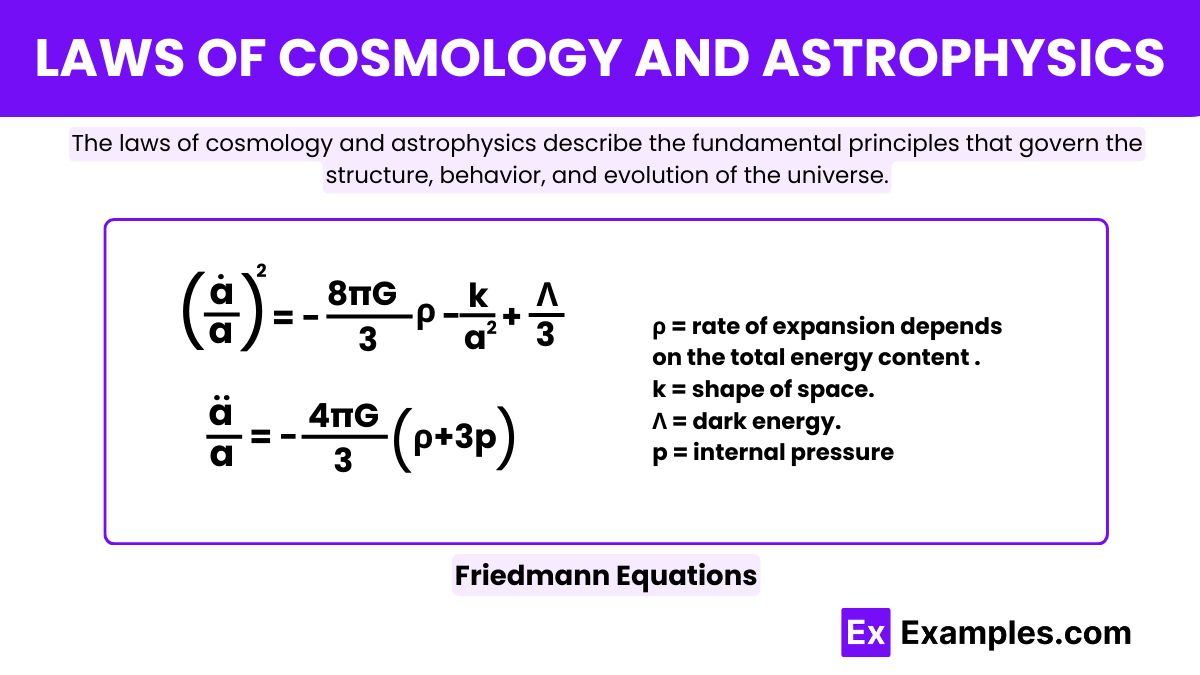What does Hubble's Law describe in cosmology?
The relationship between temperature and pressure in stars
The expansion of the universe
The fusion processes in stars
The rotation of galaxies

Cosmology and astrophysics are fascinating branches of physics that delve into the vastness of the universe and the fundamental laws that govern it. These disciplines use the laws of physics to explore and explain the origins, structure, and eventual fate of the universe, from the smallest particles to the largest galaxies. By studying these laws, scientists can uncover the mysteries of black holes, dark matter, and the cosmic microwave background, offering insights into how the universe began and how it might change in the future. Through the lens of physics, we can connect the behavior of the universe on a grand scale with the fundamental principles that also apply here on Earth.
The history of the laws of cosmology and astrophysics traces back to ancient civilizations, where early astronomers used observations of the night sky to explain celestial phenomena. The Greeks, particularly with figures like Aristotle and Ptolemy, developed geocentric models of the universe, placing Earth at the center. However, the work of Nicolaus Copernicus in the 16th century revolutionized this view by proposing a heliocentric model, with the Sun at the center of the solar system. This shift laid the groundwork for modern astrophysics and cosmology.
In the 17th century, Sir Isaac Newton formulated the law of universal gravitation, which mathematically described the gravitational force between objects. This law was pivotal in validating the heliocentric model and influenced the later development of celestial mechanics. Newton’s principles remained unchallenged until the early 20th century when Albert Einstein introduced the theory of general relativity. This theory provided a new framework for understanding gravity, describing it as the curvature of spacetime caused by mass and energy.
The 20th century also saw significant advances in cosmology, driven by observational breakthroughs and theoretical developments. The discovery of the expanding universe by Edwin Hubble in the 1920s supported the idea that the universe had a beginning, known as the Big Bang. Since then, further observations, such as the cosmic microwave background radiation and the acceleration of the universe’s expansion, have refined our understanding of cosmological models. These discoveries have solidified the framework within which we understand the large-scale structure and evolution of the cosmos.
The Friedmann equations are critical mathematical tools used in cosmology to describe how the universe expands. Developed by Alexander Friedmann in 1922 from Einstein’s theories, these equations link the expansion of the universe to various forms of energy such as matter, radiation, and dark energy. The first key equation shows how fast the universe’s size, represented by a factor called 𝑎(𝑡)a(t), changes over time. It is given by:
This equation tells us that the rate of expansion depends on the total energy content (ρ), the shape of space (k), and the mysterious dark energy (Λ).
The second equation focuses on whether the expansion of the universe is speeding up or slowing down, influenced by the same factors but also including the internal pressure (p) of the universe. It’s expressed as:
Together, these equations help astronomers understand how the universe evolves, guiding predictions about its future based on the balance between gravity, space curvature, and dark energy.
Yes, indeed, astrophysicists frequently study cosmology as it delves into the universe’s origin, structure, and overall dynamics.
Interestingly, John Herschel is often regarded as the father of astrophysics due to his pioneering work in spectral studies.
The three main branches of astrophysics are observational, theoretical, and computational astrophysics, each focusing on different aspects of the field.
Text prompt
Add Tone
10 Examples of Public speaking
20 Examples of Gas lighting
What does Hubble's Law describe in cosmology?
The relationship between temperature and pressure in stars
The expansion of the universe
The fusion processes in stars
The rotation of galaxies
According to Kepler's First Law, what is the shape of the orbit of a planet around the Sun?
Circular
Elliptical
Parabolic
Hyperbolic
What is the cosmological principle?
The universe has a center
The universe is homogeneous and isotropic on a large scale
The universe is static and unchanging
The universe is flat
What does the Schwarzschild radius define?
The size of a galaxy
The radius of a neutron star
The event horizon of a black hole
The orbit of a planet
Which of the following is true according to the Big Bang Theory?
The universe has always existed in its current state
The universe began from a singularity and has been expanding ever since
The universe is contracting
The universe is in a steady state
What does the term "dark energy" refer to in cosmology?
Energy from black holes
Energy from dark matter
A mysterious force driving the accelerated expansion of the universe
Energy from neutron stars
According to the Stefan-Boltzmann Law, how does the total energy radiated per unit surface area of a blackbody relate to its temperature?
It is directly proportional to temperature
It is inversely proportional to temperature
It is proportional to the square of the temperature
It is proportional to the fourth power of the temperature
What does the Chandrasekhar limit refer to?
The maximum mass of a stable white dwarf star
The minimum mass of a neutron star
The size of a galaxy
The maximum temperature of a star
What is Olbers' Paradox?
The question of why the night sky is dark despite the infinite number of stars
The apparent retrograde motion of planets
The discrepancy in the age of the universe
The conflict between quantum mechanics and general relativity
What does the term "cosmic microwave background radiation" refer to?
Radiation from stars
Radiation from black holes
The afterglow of the Big Bang
Radiation from galaxies
Before you leave, take our quick quiz to enhance your learning!

